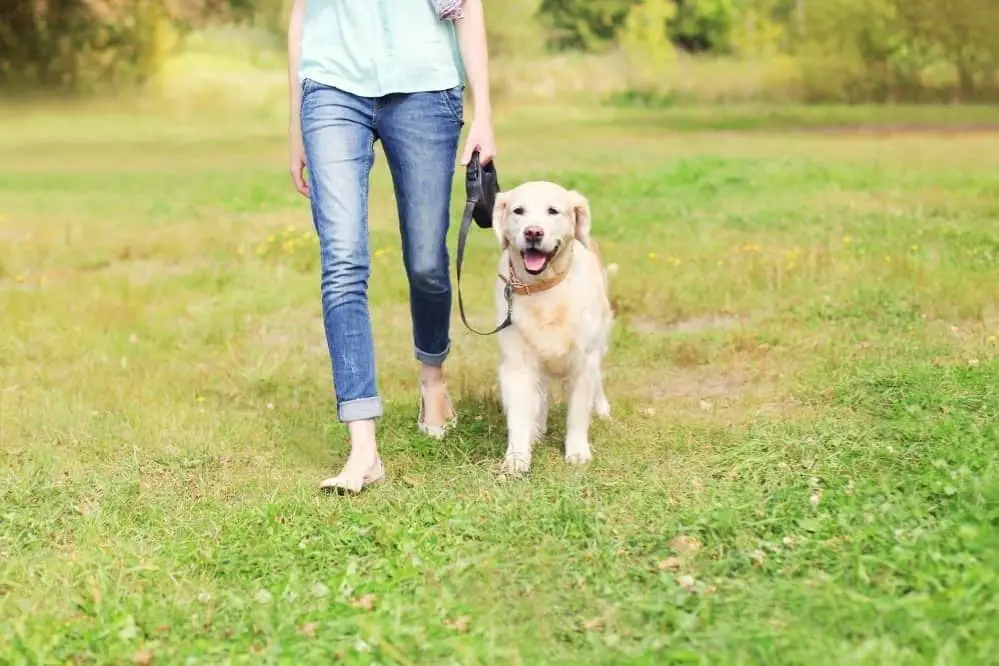Dog walking is essential for their health and happiness, so it’s important to walk them every day. However, how often you walk your dog is surprisingly complex, with several factors to consider. Let’s look at the details and figure out how much you should walk your dog.
Walks or Potty Breaks?
The first thing to distinguish is whether you are walking your dog or simply giving them a break to go potty.
For people who have a yard or garden, letting them out for a few minutes to relieve themselves isn’t the same thing as going for a walk, so proper walks are still needed.
People who don’t have a yard or garden, who use walks to give their dog a chance to go potty, may need to take more short walks throughout the day to provide their dogs with both walks and potty breaks.
Dogs need to relieve themselves several times a day like people do. They typically defecate a short time after every feeding. Most dogs need 3-6 potty breaks a day, depending on their feeding schedule.
Walks, on the other hand, are important for a dog’s physical and mental health. Walks are an opportunity for a dog to:
- Relieve themselves. Even when a dog has had plenty of potty breaks, they will often also relieve themselves during a walk
- Get mental stimulation. Even when dogs are walking in the same outdoor environment, their sensitive noses bring them all the day’s “news.” The sights, sounds, and smells of being outdoors, particularly somewhere new and different, provide mental stimulation for a dog. Without it, dogs can become bored, and boredom can lead to destructive behavior
- Get physical exercise. Like people, dogs need physical activity for heart and lung health and to maintain a healthy weight. Walking helps dogs burn up physical energy, so they can be more relaxed when indoors
- Gain experience with training and socialization. Walks are an excellent opportunity to help socialize a dog to other dogs and people and reinforce good training behaviors.
- Bond with you. The shared experience of walking, exploring, and exercising can be a bonding experience between a dog and owner. Walks are a form of quality time that helps you and your dog build a deeper connection and understanding
In other words, dogs need to be allowed to go outside to relieve themselves. They also need walks for healthy mental and physical exercise. Walks and potty breaks aren’t the same thing.
How Many Walks Does Your Dog Need?
Different dogs have different biological activity levels. Certain breeds need more exercise than others, but there is also individual variation. A dog’s needs change over time: puppies are usually much more active than older dogs, so your walking habits will change over time.
As a rule, to be healthy, dogs need:
- 30-120 minutes of exercise every day
- Potty breaks after every meal
- For most people, a typical dog walking schedule might look like this:
- A potty break first thing in the morning
- A short morning walk (15-20 minutes) a little while after breakfast
- A mid-day potty break
- A potty break in the afternoon and/or evening
- A longer walk or run (30 minutes or more) after dinner
- A potty break before bed
How Much Walking Does Your Dog Need?
Because there is so much individual variation in the amount of exercise dogs need, it’s a good idea to let your dog tell you how active they want to be.
An excellent way to find out your dog’s specific exercise needs is to take them for a long walk and pay close attention to their behavior. If they start walking eagerly, at a good pace, and with enthusiasm, keep up their pace and note the time.
If your dog starts to slow down after 20-30 minutes, spending more time looking and sniffing around and not showing as much energy, then turn around and head home. Pay attention to whether your dog starts to slow and lag more on the walk home, as it’s a sign that they are tired.
It’s essential to also pay attention to your dog’s behavior once they get home. Does your dog immediately drink a lot of water and then lay down for a long nap? That’s a good sign that they exhausted themselves on their walk.
On the other hand, you may have a dog that can go for a long walk to a dog park, run around at top speed in an off-leash area, and still have plenty of energy left for the walk home. That’s a sign that your dog needs a lot of exercise, and you should increase walk frequency and duration.
Suppose you can’t walk your dog as much as they need. In that case, you may want to consider hiring a dog walker or placing them in a dog daycare that offers opportunities for exercise.
If your dog is overweight and reluctant to go for walks, remember that walks are important for their heart health and weight maintenance. Try to gradually increase the length of your walks, going for just a few minutes longer every time, until they are walking for at least 30 minutes a day.
The important thing to remember is not how often you walk your dog, but for how long. Dogs, like people, need 10-15 minutes at a time of continuous activity for heart health and at least 30 minutes a day of good exercise to get all the physical, mental, and emotional benefits of a walk.
Conclusion
Walking is critical for a dog’s health and well-being. It’s usually better to err on the side of more and longer walks rather than not walking them enough. Since dog and human activity needs are so similar, you can also think of these walks as taking care of your own health as well as your dog’s.

